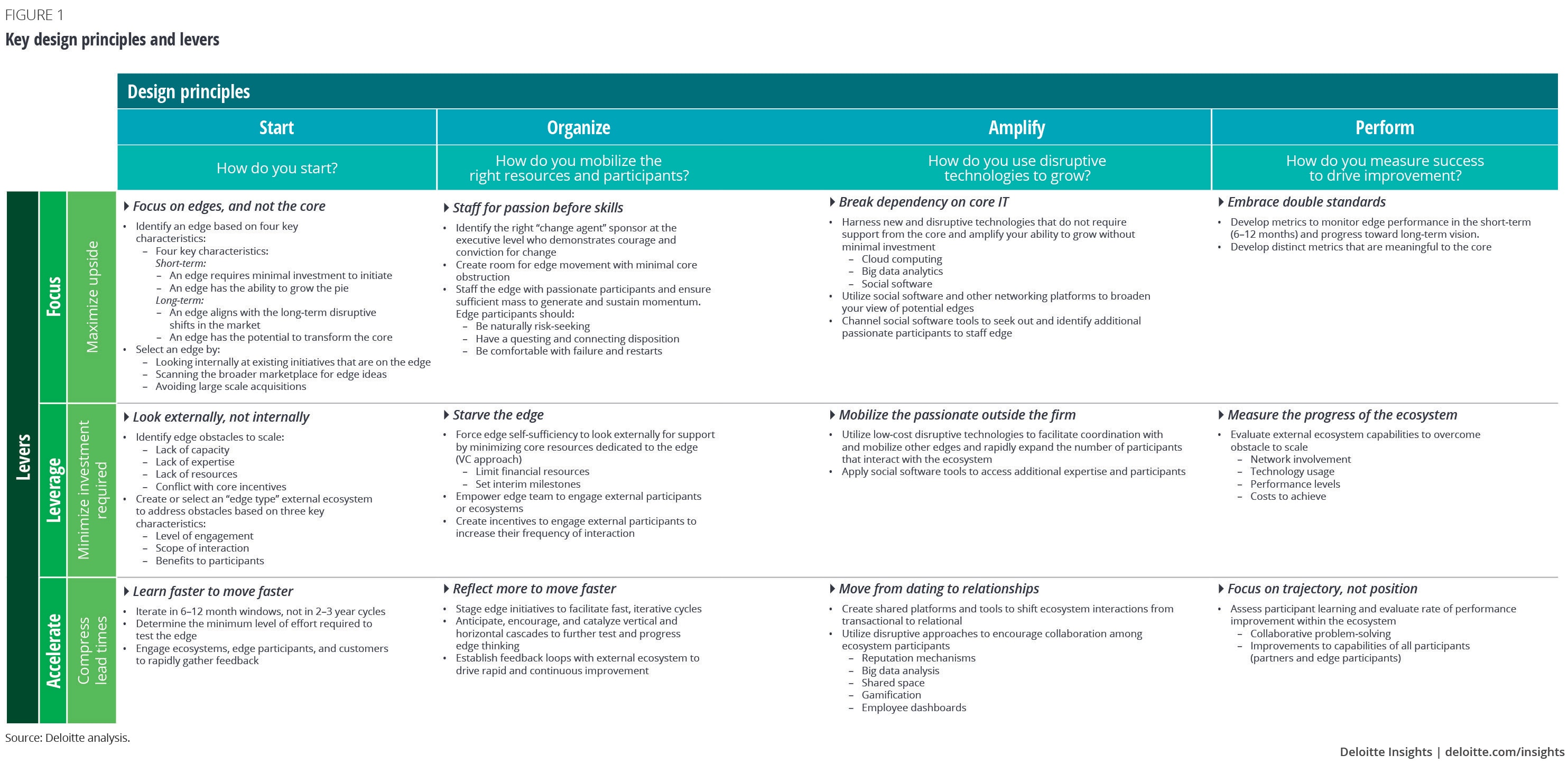
Change from the outside in Scaling edges to drive transformation
4 minute read
10 July 2019
In a post–Big Shift world, success requires more than cost-cutting. Leaders need to rethink their companies' role in the broader business environment—and that may begin with identifying opportunities on the edge.
The world as we know it is changing. Increased globalization and rapid advancements in technology, collectively referred to as the Big Shift, are profoundly altering our economy and creating new market opportunities for the firms that can understand and anticipate their impact.1 Some companies have grown rapidly by identifying market opportunities that a few years ago were all but nonexistent. While some firms have benefited handsomely, these same fundamental shifts have exposed other companies to significant performance pressures.
Learn more
Read more from the Innovation collection
Download a custom PDF
Subscribe to receive updates from the Center for the Edge
Download the Deloitte Insights app
When Deloitte first published Scaling edges in 2012, Amazon’s continuing rise and Borders’ collapse was the most prominent example of how companies faced a growing imperative to change and adapt—and how not all were responding effectively to that imperative. Since then, the business landscape has seen any number of cases further illustrating the trend. Even some of the companies cited here fell victim to the increasing rate of change; they were disruptors that, only a few years after making an impact, were themselves disrupted.
To thrive in a post–Big Shift world, today’s companies should consider how they move from innovating at a product and service level—that is, flooding the market with new, marginally improved products—to innovating at an institutional level. This change requires firms to rethink even the primary objective of why they exist and drastically change their management mindset; in today’s rapidly changing landscape, a focus on scale efficiencies is not enough. Transformative change is required.
We see pragmatic pathways as a framework for executives seeking to embark on this difficult but necessary transformation. The full report, Scaling edges: A pragmatic pathway to transformation, introduces and breaks down the three prongs of the framework:
First, by focusing on edges rather than the core of a company, change agents can better identify opportunities that align with Big Shift forces and therefore are most likely to achieve significant and sustainable returns.
Second, by leveraging external resources and low-cost technologies rather than internal support, these edges can circumvent the scrutiny and organizational resistance with which change initiatives are typically met, allowing the edge to move faster.
Finally, by accelerating learning rather than focusing solely on short-term outcomes, edges can rapidly demonstrate impact, pulling the organization to the edge, and becoming conduits of transformation that help today’s companies innovate the institution and tap into tomorrow’s opportunities.
Edges, and how to scale them
A combination of factors separates an edge from other types of growth opportunities. While new market opportunities may arise from many catalysts (changing consumer preferences, product innovation, etc.), edges are a byproduct of the Big Shift and therefore exhibit a strong correlation to the fundamental shifts, driven by globalization and rapid advancements in digital technology.
This correlation with fundamental shifts may reveal itself only in the long run. In the short term, a second key characteristic of an edge is that it requires minimal investment to initiate. Large upfront investments place great scrutiny on traditional growth initiatives and raise latent political antibodies to change if the leadership team is uncomfortable with the initiative. In order to further minimize pushback from internal business units, an edge should have the ability to grow the pie, meaning it does not cannibalize existing revenue streams or pose a threat to core projects. In the long run, however, the edge must have the potential to become the new core, meaning that as the edge scales, it pulls more and more resources into it and ultimately becomes the new core of the enterprise.
For many—even most—organizations, the problems are both obvious and long-term; indeed, many executives and board members acknowledge that profitability and performance are eroding—how could they not? And yet most ailing firms take one of two avenues to alleviate these concerns: aggressively cut costs or develop new products and services to raise revenue. While these are conventional strategies, both often offer diminishing returns for companies. As the Shift Index shows, cost-cutting and layoffs can provide firms with immediate bottom-line relief, but these cuts’ effectiveness usually shrinks as companies push harder on their existing resources. Meanwhile, increasing revenues through product or service innovation is becoming more difficult, with both competitive intensity and brand disloyalty on the rise. As product life cycles compress and customers grow increasingly fickle in their purchasing patterns, firms that innovate solely by flooding the market with new products are at risk.
Capturing opportunities in a post–Big Shift world requires more than cutting costs or introducing new, marginally differentiated products and services. Success demands that leaders seriously challenge their current playbook and rethink the way they see the world and the company’s role in the broader business environment. Executives may need to change the lens through which they view their firm in order to start identifying the edge that can gain momentum and ultimately transform their organization. Within many companies, there is tremendous opportunity for innovation and growth right now—on the edge.
Download the full Scaling edges report for a deeper exploration of edges—and how to convert energy there into transformational change.
Read more about emerging technologies
-
Emerging technologies Collection
-
The power of scaling the edge Article5 years ago
-
The duct tape guide to digital strategy Article5 years ago
-
How digital reality could help marketers tell better stories Article5 years ago
-
Reimagining customer privacy for the digital age Article5 years ago
-
Flying smarter with IoT Article5 years ago














